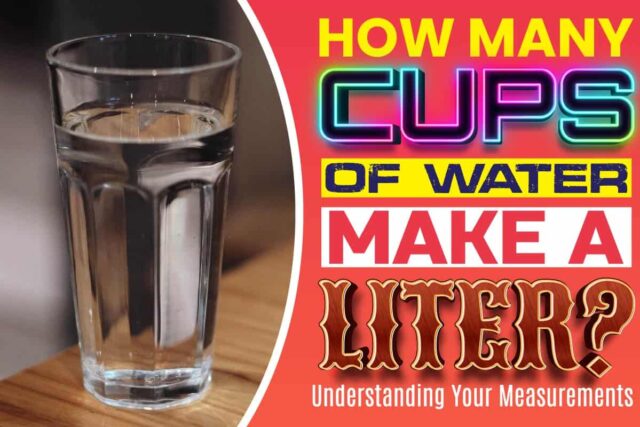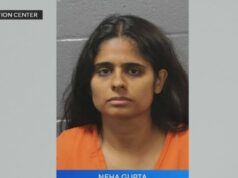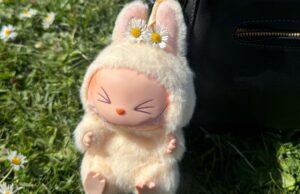Getting the correct measurement is essential, especially for confectioners, chefs, individuals trying out new recipes, or people who offer catering services. The need to get it right or ruin a potentially good creation is daunting.
Often people in this line of work are faced with recipes that require measurements in different, sometimes unfamiliar, metrics—for example, milliliters or cups.
So, let’s answer the question.
How many cups of water make a liter?
One liter equals 4.2 US cups. Since 1 liter is 1000 milliliters (mL) and one US cup is 236.5 milliliters (mL), 1000/236.5 equals 4.2 US cups.
There are several other types of cups aside from the US cups. And the measurements often differ for the different types of cups.
This post contains more information on this topic. Read on:
What Is A Liter?
A liter (L) is a volume unit. It is not an SI unit, but the International System of Units recognizes it. One liter will add up to one cubic decimeter, 1,000 cubic centimeters, or one thousand cubic meters.
What Are The Uses Of A Liter?
The liter is for measuring the quantity of many liquids as well as tagging containers containing those liquids. It is also for measuring the volume of no-liquid items.
These non-liquid items include computer cases, recycling bins, containers, car trunks, backpacks, microwaves, and refrigerators and conveying fuel volumes and rates in most nations worldwide.
What Is The Origin Of Liters?
From 1901 to 1964, a liter was the volume of one kilogram of pure water at atmospheric pressure under maximum density conditions.
However, the definition of liter reverted to what it currently is because of the challenges of controlling the mass-volume relationship of water based on several variables and discovering that the prototype kilogram was slightly too large. The variables included the uniformity of the isotopes, pressure, and temperature.
What Is A Cup (Unit)?
A cup is a measure of volume used mainly in cooking and in serving. In the US system, it is equal to 236.5 milliliters. This measurement varies with different locations.
Drinking cups and other cups come in varying sizes, so they aren’t to be used in place of measuring cups. For cooking and serving measurements, you should use a standard cup.
What Are The Uses Of A Cup?
The cup is primarily for measurement in cooking. It is for measuring water and other liquids and even solid ingredients. Although, you may need a separate cup for your solid ingredients.
Being a chef or confectioner isn’t a prerequisite for using a cup. Amateurs and people trying out new recipes may use it. It is most useful for cooking.
Some recipes require that you follow them to the latter for the best results. You can do a lot with a kitchen scale, but you can only do so much, especially when liquid is involved. To get the precision that many recipes require, using a cup is necessary.
Types Of Cup
The measurement often differs from country to country, although the US cup has gained more popularity. The type of cup determines the measure.
Sometimes, individuals come across recipes from different regions. Measurements in the recipes may be according to the type of cup used in the area. For example, somebody in the US trying to recreate a recipe from the UK might have measurement issues if they are not aware that the US and UK use different cups.
Here is the type of cups available:
The metric system:
1 L equals 1000ml, and a cup equals 250ml in the metric system. To calculate the number of cups in a liter, divide 1000ml by 250ml (1000/250ml). It shows that 4 cups make 1L in the metric system.
The US system:
The US cup is for measuring liquids in the United States. One US cup equals 236.5 ml or 8 US fluid ounces. At the same time, one 1L is 1000 mL or 33.8 US fluid ounces. It means that there are 4.2 US cups in a liter of water.
The imperial system:
British people use the imperial system. 1 imperial cup equals ten imperial fluid ounces or 284.1mL. At the same time, 1L equals 35.2 imperial fluid ounces and
1000ml. It means that there are 3.5 imperial cups in a liter.
Different Ways To Calculate The Number Of Cups In A Litre
We know that if measurements aren’t accurate, it may affect what you’re trying to prepare. It is, therefore, necessary that measurements are gotten right.
Some cups are in millimeters, which makes your job easy. We all understand that 1 liter is equal to 1000mL. So, for the 250 ml cup (1000/250= 4 cups), 4 cups make one liter.
What do you do if your cup isn’t in milliliters?
STEP 1- Using a US standard cup
You should know this by now:
1 litre= 1000mL
1 US cup=236.5mL
The number of cups in a litre= 1000/236.5= 4.2 US cups.
STEP 2- Using a cup marked in oz units
Oz is used to refer to an ounce.
A liter=33.8 oz
A cup= 8 oz
The Number of cups= 33.8/8= 4.22 cups
STEP 3 – Using the quart
You can calculate the number of cups in a liter by calculating the quart in a liter. A quart is one quarter of a gallon or two pints.
1L= 1.057 quart
A quart= 4 cups
The number of cups in a liter= 4*1.057= 4.228 cups
STEP 4 – Using pints and quarts
1L= 1.057 quarts approximately 1.06
1 quart= 2 pints
1 Pints = 2 cups
Since, 1 quart= 2 pints
1.06*2= 2.12 pints
And since Each pint is 2 cups.
Cups in a litre= 2.12*2 = 4.24 cups.
How To Convert More Than 1 Litre To Cups
This conversion isn’t difficult. Since you already know how many cups are in 1 liter, all you need to do is multiply the number of liters by the number of cups in one liter.
For example, to find out how many cups are in x liters:
Using:
The US system, X*4.2= number of cups
The metric system, X*4= Number of cups
The imperial system: X*3.5= number of cups.
So, if X=2L
Then,
The US system 2L*4.2= 8.4 cups
The metric system, 2L*4=8 cups
The imperial system, 2L*3.5= 7cups
Dry Cups And Liquid Cups
Dry measuring cups are for measuring dry cooking ingredients, like flour, sugar, berries, etc. In comparison, liquid measuring cups are for measuring liquids. They are both designed to fit their individual use.
When using a dry cup, you can level off dry ingredients. But you wouldn’t be able to do the same if you were using a liquid cup to measure dry ingredients simply because liquid cups have a structure that allows overflow.
Can Liquid Measuring Cup Measure Dry Ingredients Accurately?
First off, provided it is a standard cup, the dry and liquid measuring cups have the same volume. But, it isn’t a wise decision to use one cup for both liquid and dry ingredients.
Many chefs and confectioners have tried to see if you get the same result if they use the two cups interchangeably. The results have shown that there is a slight difference. Here is how to try it yourself:
- Get the dry and liquid measuring cups and flour.
- Fill up your dry cup with flour.
- Level off the flour
- Weigh on a scale and record the number of ounces
- Repeat the process with the flour but use the liquid cup this time.
There would most likely be a difference between the two because you can’t level the flour in your liquid cup.
The difference might be negligible because it is just one cup. Imagine your recipe required several cups of flour. It means that your measurement would be short by a non-negligible fraction.
To Convert Cups To Liters
If you need to convert your cups back to liters, one cup is equal to 0.23 liters. To convert, you multiply the number of cups by the conversion ratio (0.23).
So, litres= cups*0.23
1 cup = 0.23L
2 cups= 0.46L
3 cups = 0.69L
4 cups= 0.92L
5 cups= 1.15L
6 cups= 1.38L
7 cups= 1.61L
8 cups= 1.84L
9 cups= 2.07L
10 cups= 2.3 L
Conclusion
The knowledge of “how many cups make a liter of water” can make measuring easy and seamless because the measurement for water can apply to the several cooking liquids available.
Measuring cups are readily available online and in physical stores. If you’re finding calculations tasking, there are several metrics calculators available on the internet.
With all these provisions, your recipes going wrong would not be from wrong measurements.














